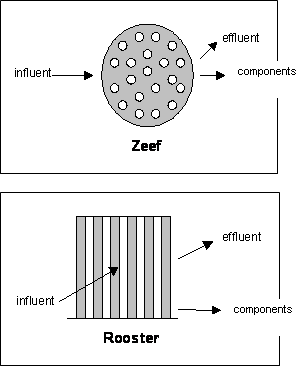Method diagram
 |
|
| Figure: Sieve/grid | Figure: Curved sieve |
Source: ESEP Milieutechniek
Method and installation description
The aim of grids and sieves is to remove large particles from wastewater. This can be done using a sieve (curved sieve, a drum sieve or vibrating sieve) or a grid. The difference between a grid and a sieve is that:
- A sieve consists of a perforated metal plate along which the wastewater passes (parallel flow)
- A grid consists of vertical rods through which the wastewater passes (through flow).
A grid is often used for rough separation and/or larger quantities of wastewater. The rough components are retained by the rods, which have a mesh size of 15-40 mm. The grid is cleaned regularly in order to prevent blockages. This can be done manually or automatically via a rake that scrapes the grid.
The macerator is a special type of grid. It cuts pollutants that pass through the sieve into finer particles whilst in the water. This normally increases the organic load.
Various types of sieves are available, and are distinguished by their mesh size. This varies from 2.5 mm to 50 µm.
- A curved sieve is a slightly curved, perforated metal plate which, if the gradient is steep enough, causes the separated particles to slide down it and into a collector.
- A drum sieve consists of a rotating drum made from perforated metal, with the wastewater entering one end of the drum. The water falls through the drum and the solid particles are transported to the other end of the drum, where they are collected in a container.
- A vibrating sieve (often) consists of a horizontal, perforated metal plate that moves backwards and forwards. The water falls through the plate and the solid particles are transported to the other side due to the vibrations. The vibrating sieve can also be set up at a gradient in order to improve effectiveness. A vacuum is sometimes implemented to improve the separation of rough particles.
Specific advantages and disadvantages
Sieving is a relatively cheap and fast technique. Odour problems may be encountered, particularly with organic pollutants.
Application
Grid or sieve treatments are performed in all sectors where rough dirt is encountered in the wastewater. This can include, for example, packaging materials, rags, leaves and twigs. Roosters and sieves protect all mechanical components that lie down-flow.
Curved sieves and sieve drums are used for the treatment of wastewater from slaughterhouses, potato processing, fish processing, vegetable processing, textile washing and greenhouse cultivation.
Boundary conditions
The wastewater must only contain 10-50% rough particles. If loads are too high, it becomes impossible to clean the sieves. In this case, sieves can also be set up in a series – from rough to fine.
Effectiveness
The removal of organic substances (e.g. BOD) amounts to 5 to 20%. The removal of suspended matter amounts to 5 to 25%.
Support aids
None
Environmental issues
Rough, often organic components are released as by-product. It may also be necessary to measures against odour problems.
Costs
The investment costs for a manually cleaned grid with a capacity between 10-100 m3/d are estimated at €1.700 to €3.000. For volumes between 500-5000 m³/d this will be €5.000 to €10.000. Operational costs are estimated at between 0.005 (for non-automated systems) to 0.15 €/m³ (for automated systems).
Investments costs for a curved sieve are estimated at between €8.500 and €25.000 for a volume of 50 to 500 m³/d. Operational costs amount to between 0.01-0.35 €/m³.
Comments
None
Complexity
Sieves and grids are very simple techniques.
Level of automation
The level of automation is low due to the simplicity of the equipment. It may be possible to clean the grids automatically.
References
- AEA Technology, Manual of Effluent Process Technology, Environmental & Process Engineering Department, Harwell (GB), 1991.
- Baeyens J., Hosten L. and Van Vaerenbergh E., Wastewater purification, Environment Foundation - Kluwer Editorial, 1995
- EIPPCB, Reference Document on BAT in Common Waste Water and Waste Gas Treatment / Management Systems in the Chemical Sector, draft February 2009 (revision upon release)
- Koot A.C.J., Treatment of wastewater, 2nd edition, Waltman Publishers, Delft. 1980.
- TNAV, supplier survey, 2008
- VITO-SCT, revision of technical notes WASS, 2009
Version February 2010

